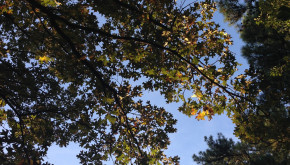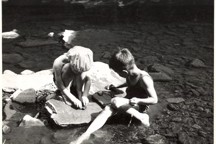
Attaching Your Child to Your Land
Nancy G.W. Baker, PA Forest Steward, Bradford County
I remember with great fondness that you can draw with some of the stones in our creek, rubbing the wet red pebbles and the gray-green stones on the large flat rocks (see photo at left of the author and her cousin drawing on rocks in the creek). The drawings are ephemeral; they either bake to a powder in the sun or wash downstream in the rain. My attachment to the stream, however, seems permanent. And the land too, under the fireflies and the spiderwebs, the pilot snakes and pines, the darn deer and the bugs, is under my skin.
Richard Louv, author of the best seller Last Child in the Woods, writes, “When people talk about the disconnect between children and nature—if they are old enough to remember a time when outdoor play was the norm—they almost always tell stories about their own childhoods: this tree house or fort, that special woods or ditch or creek or meadow. They recall those ‘places of initiation,’ in the words of naturalist Robert Michael Pyle, where they may have first sensed with awe and wonder the largeness of the world, seen and unseen.”
Reader, it’s likely you have children, perhaps grandchildren, and it’s probable that you own forest land too. If you wish your offspring to have some attachment to that land, if you expect them to care for it as you do when you turn it over to them, begin now!
Think of this: I have a cousin. He has forested land and family. The family lives in Ohio; he has a Pennsylvania Forest Stewardship Plan. The plan, designed by a consulting forester with the assistance of the West Virginia Office of the Nature Conservancy, has as an objective the attachment of his grandchildren to this particular piece of Pennsylvania land. An entire section of the Forest Stewardship Plan has activities for six children, now aged 3 to 13; the explanations are detailed, and there’s an appendix to help mom and pop along.
For example: (the condensed version!)
· Draw a map; give names to all the places you identify.
· Print an aerial photo of your land (magnify it, perhaps you’ll need to tape it together), mount it on cardstock, cut out each field, forest block, house, barn or habitat to make the puzzle pieces.
· Go on a scavenger hunt: Assign scavenger lists that require a child to think creatively or to look very closely (e.g., A chewed leaf (not by you!), something that makes a noise, exactly 100 of something).
· Call in predators: buy a predator call at a sporting goods store and use it to draw in animals for a closer look.
· Watch a thunderstorm move across the landscape; learn to know the clouds.
· Create a wild garden: Identify, map, and label the plants so friends can see and learn about the natural diversity of flowers and other plants growing in your woods.
· Build a bird box, mount it in the correct habitat, and monitor the occupants.
· Identify animal and bird tracks by taking photos in mud or snow; see if you can follow their trails.
· Keep a journal with notes, pictures, drawings and found objects.
· Sleep outside (remember the bear spray).
What’s happened in the years since the plan was created? There’s a much loved children’s map with the Fairy Forest and the Super Hill of Doom (see photo at left of The Children’s Map by Amanda Layman. Copies of this map are laminated and used as placemats for all the cousins’ and friends’ meals at the farm). There’s a secret fort. There are piles of sleeping bags and a telescope for watching the stars. There’s a little girl who wanted to know what all the different caterpillars were one summer. New collections of stones sit among old collections of moths; the sand mound is seeded with wildflower mix; and it once took a whole weekend to hang up the tire swing on the highest branch. Everyone brings their friends and shares their fun in the woods and fields.
Begin now. Introduce your next generation to your woods; you can make it their “place of initiation.” A 3-year-old can identify a cedar tree and a maple—even if she can't tell you what color pants she's wearing. And a 4-year-old can tell the difference between squirrel and rabbit tracks—even if he can't yet read any of the writing on a map. Young children learn through the sounds, scents, and seasons of the outdoors.* You will find a wonderful beginning resource guide to introducing your child to your outdoors at http://richardlouv.com/children-nature-resources. And if you are attached to your piece of land, share and teach your attachment to those future owners.
*Milwaukee Journal Sentinel, April 2006



